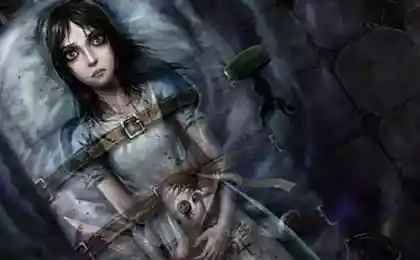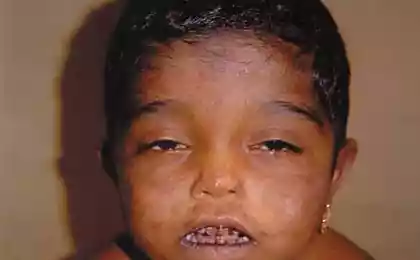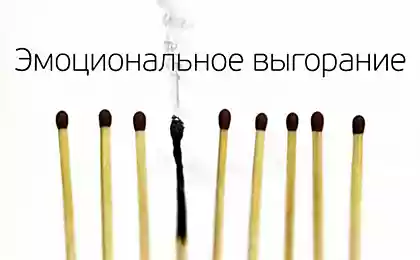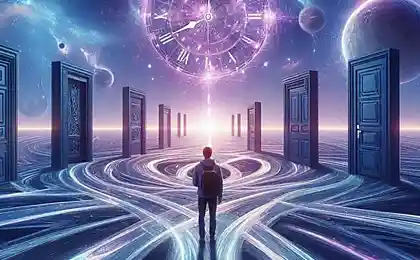728
10 rare psychopathological syndromes

© Felix Günzler
Paris syndromeAnxiety at the sight of the French.
Disorder called Paris syndrome is most common among Japanese tourists. According to the foreign Ministry of Japan, every year at least 12 of them seek help with a therapist during or after a trip to France and other Western European countries. Travelers experience culture shock, complain about the aggressive behavior of the locals and staff, suffer from the fact that their expectations and investments of effort and money are not justified. For some, it ends the strongest psychosis, which requires months of therapy. "For us, Paris — dream city, says one of the victims. — All the French are beautiful and elegant. But when we meet them face to face, we realize that deeply mistaken. We are totally different in personalities and views on life."
Paris syndrome was identified in 1986 by Japanese psychiatrist Hiroaki Auteuil, who worked in France. OTA found that it is characterized by sharply emerging delusional disorder, hallucinations, delusion of persecution, derealization (a disorder of the perception of others), depersonalization (a disorder of the perception of the own body), anxiety, and nausea, tachycardia and excessive sweating.
In the embassies of Japan around the clock hotline assistance to people suffering from Paris syndrome. A similar disorder occurs in Chinese travelers, who also tend to romanticize Western Europe. "Don't put the phone on the table in a cafe and don't wear bright jewelry!" warns Chinese guide to Paris for 2013.
Stendhal syndromeHallucinations in museums.
Stendhal syndrome occurs when the acquaintance with the works of art in museums and art galleries. Its symptoms are somewhat similar to Paris syndrome: dizziness, hallucinations, tachycardia, loss of spatial orientation, fainting, hysteria, destructive behavior. This disorder can also occur during observations of natural phenomena, animals, listening to music of the romantic era and meeting incredibly beautiful people.
A French writer tells of his experiences his crisis in his book "Naples and Florence: a journey from Milan to Reggio". "When I came out of the Church of the Holy cross, writes Stendhal, is my beating heart, I thought that dried up the source of life, I was afraid to crash down to earth... I have seen the masterpieces of art generated by the energy of passion, and then everything was meaningless, a small limited, so when the wind of passions ceases to inflate the sails that push forward the human soul, then it becomes devoid of passions and vices and virtues".

For the first time, the Stendhal syndrome was described in 1979 by Italian psychiatrist Graziella Magherini. She researched more than a hundred of the same occurrence of this disorder among tourists visiting Florence. While Mogherini noted that travellers from North America and Asia are not affected by the Stendhal syndrome due to the fact that the local works of art are not associated with their culture, and the Italians are immune because you get to know them in childhood. The psychiatrist noticed that the most disease prone lonely foreigners with classical or religious education: men and women.
Stendhal syndrome really is most likely to occur to visitors to the museums in Florence, especially the Uffizi gallery. Ill suddenly struck to the core by the beauty of the artwork and begins to perceive emotions invested in it by the artist, with extraordinary sharpness. In some cases this even results in attempts to disrupt the picture or damage the statue. That's why, despite the fact that Stendhal syndrome is quite rare, employees Florentine museums are taught how to behave with victims.
HospitalismDisease hospital.
Psychopathological disorder that occurs during and after a stay in state and public institutions, called hospitalism. It appears in children and adults who have a long time to live in hospitals, baby homes, nurseries and nursing homes.
The term "hospitalism" was first used in 1945, the Austro-American psychoanalyst Rene Spitz studying the behavior and status of children on treatment. For children hospitalism characterized by a marked physical and mental retardation, emotional distress, meaningless movements (e.g., rocking), weakness, crying, lethargy, weight loss, lack of visual tracking for others and a voice answers on the affection. This disorder inhibits the intellectual and emotional development of the child, it distorts the concept of perception of self and bad for the health. In severe forms of hospitalism can lead to infant insanity, chronic infections and even death.
In adulthood this disorder usually occurs in elderly patients who are in the hospital more than 10-15 months. For adult hospitalism characteristic of social exclusion, loss of interest in work and loss of skills, the deterioration of contact with others and the desire to recognize their chronic disease. Particularly hard to hospitalism exposed to patients of psychiatric wards of hospitals. The researchers note that often the hospital stay is harmful to such patients more than the actual mental illness, because of which they got there.
Syndrome of DiogenesDisregard for yourself.
Patients with Diogenes syndrome — a pathological drives that suffer from extreme neglect yourself, apathy, emotional instability, suspicion and lack of shame. All this often turns against them. Diogenes syndrome often leads to social isolation, which increases as the dwelling of a person accumulates the trash, and appearance changes under the influence of the disease. Such people accumulate a huge amount of unnecessary things, indifferent to dirt and debris, unfriendly to visitors and, as a rule, one way or another resist attempts to help them change their lifestyle. However, they are not always poor: I just prefer not to spend money.
It is believed that the syndrome of Diogenes occurs because of disorders in the anterior cingulate gyrus and insular lobe, which is usually involved in the decision-making process. American researchers found that at rest in these patients had abnormal activity in these areas, while in the moments when a decision really had to make, their work was silent. Diogenes syndrome may be a consequence of depression and dementia. In psychiatric practice it is also called the hoarder syndrome senile squalor and social decay. Today its prevalence in the world is about 3%. Most often, this syndrome is seen in Mature and elderly.
Curiously, the ancient Greek philosopher Diogenes, apparently, does not suffer from the disorder named after him. Diogenes adhered to the strategy of extreme minimalism and, according to legend, lived in a barrel, but remained socially active and had a sharp mind and was not involved in the accumulation of property.
The syndrome of Dorian grayMorbid cult of youth.
The syndrome of Dorian gray, named after the main character of the novel of Oscar Wilde's "the picture of Dorian gray", a mental disorder is now recognized everywhere. It was first described in 2001, and many experts consider it more of a cultural and social phenomenon. However, this condition can be dangerous, because in some cases leads to depression and suicide attempts.

Patients with the syndrome of Dorian gray experience a panic fear of aging and abuse of cosmetic procedures and plastic surgery, not caring about the risks. Sometimes they also compensate for an offense addiction to youth symbols and clothing. People with the syndrome of Dorian gray meets narcissism, immature and dysmorphic disorder, when a slight defect appearance cause constant anxiety, fear, depression, low self-esteem. The syndrome of Dorian gray may have famous actors and musicians, which plays an important role in their profession physical appearance.
Manichaean deliriuma War between good and evil.
Manichaean delirium is a severe, painful condition in which the patient seems to be that all around him there is a struggle of light and dark forces, and the bet in this fight — his soul and body. Some experts believe Manichaean delirium acute kind of antagonistic nonsense and attribute it to the category of delusions of grandeur. Others view this disorder as one of the stages of oneyroid — dreamlike, fantastic, delusional aberration state.
A person who suffers Manichaean delirium, he feels himself on the verge between good and evil. Plagued by conflicting auditory hallucinations and fear of impending disaster. Here's how describes his as one of the patients: "Two times a day I go to Church and always wear a Bible because I find it hard at all to figure out. At first I did not know what is right and where sin. Then I realized that all is God and all is the devil. God calms me and the devil tempts. Drinking, for example, water, made extra SIP of sin, God helps redeem read prayers, but then there were two voices, one God, the other the devil, and they began to argue and fight for my soul, and I'm confused." Thus, a person suffering from delusions of Manichaeism, seems to be healthy, and this makes his condition a danger to others. Experts believe that terrorists and suicide bombers may become a people prone to Manichaean delirium. It has been suggested that this disorder suffered Adolf Hitler and George W. Bush.
Stockholm syndromeLove for the aggressor.
Stockholm syndrome is not included in any international list of mental illnesses, however, is perhaps the most famous "rare disorder". This condition occurs when the victim begins to sympathize with his captor, experience to his unilateral or mutual sympathy and even identify with him. Some experts believe Stockholm syndrome is a natural reaction to events that traumatize the psyche. In the world of psychotherapeutic practice there and home of the Stockholm syndrome, which occurs against a background of domestic violence.
The desire to identify with the aggressor, it was first described by Anna Freud, daughter of Sigmund Freud, in 1936. And after the hostage-taking at the Bank Kreditbanken in Stockholm in 1976, this syndrome got its modern name. Then the ex-convict, Jan Erik Ulsson single-handedly captured the Bank, took hostages four of his workers and held them for six days. During this time, he had no time to join his cellmate, Clark Olofsson, who was brought to the Bank at the request of the offender. The hostages were released during a special operation with the use of gas, but then they said that was not afraid of the invaders, and the police. Olofsson on the court was able to prove that didn't help terrorist, but rather was trying to save people. He was acquitted of the charges and released, after which Olofsson met and befriended one of the hostages. Ollson was sentenced to 10 years in prison. In prison, he received several admiring letters from his victims.

Experts say that Stockholm syndrome is very rare: according to the FBI, obtained after an analysis of 1200 successful attempts of hostage-taking, he formed the victims only in 8% of cases. However, during operations to liberate the trapped people of negotiators encourage the development of mutual sympathy between terrorists and their victims. This reduces the risk of death of the hostages and increases their chances of release.
The savantIslands of genius.
Savant syndrome occurs in people suffering from autism and other mental illnesses, but can also be a consequence of traumatic brain injury. In this case, given the General limitations of the personality occurs, an "island of genius": a phenomenal memory and an incredible ability in the field of music, arithmetic, art, cartography, architecture, three-dimensional models or in a different field. Savant is able to sing all the arias heard, coming from the Opera, called the day of the week that falls on January 1, 3001 and implement in mind the calculations usually produce a computer. With the remaining abilities and skills it can be developed very badly, right up to mental retardation.
American actor Dustin Hoffman received the "Oscar" for the role of savant Raymond Babbitt in "rain Man". To do it, Hoffman's long time friends with Kim Peak — Zaventem with a phenomenal memory and ability to read, which was noted on his background of many pathologies. Peak details remembered maps of all cities in the United States and could give me advice on how to pass each of them, and to read one page of text he took only 8-10 seconds.
Psychosis impactthe thoughts of Others.
The impact of psychosis, or psychosis hypersensitivity, occurs in schizophrenia due to cessation of neuroleptics and metoclopramide, which is used to treat migraine. In this disorder, patients develop hypersensitivity of dopamine receptors. The neurotransmitter dopamine plays a big role in the reward system of the brain and produces a feeling of pleasure and satisfaction.
When psychosis returns the person has a sense that he feels his own and other people's thoughts that "come into it". Such patient suffers from hallucinations and delusions, involuntary movements and tremor. For the first time this disorder was described in 1981. Today to prevent the experts advise not to prescribe antipsychotics in anxiety and affective disorders, limiting their scope only to the treatment of schizophrenia.
Emotional burnoutFatigue vulnerable.
Burnout syndrome most often occurs in those who work in prisons, hospitals and other state institutions. This is a growing emotional exhaustion, which leads to a deep indifference, dehumanization, feeling his own professional insolvency, depersonalization, and reduced quality of life and psychosomatic diseases.
In the list of the International classification of diseases ICD-10 the syndrome of emotional burnout called burnout. In Russia it is also called professional burnout. Today, there are several Russian and foreign questionnaires that can detect this disorder from the staff. It is believed that emotional burnout are more prone to people prone to empathy and idealistic attitude, but fragile and lost in her dreams.published
P. S. And remember, only by changing their consumption — together we change the world! ©
Source: theoryandpractice.ru























